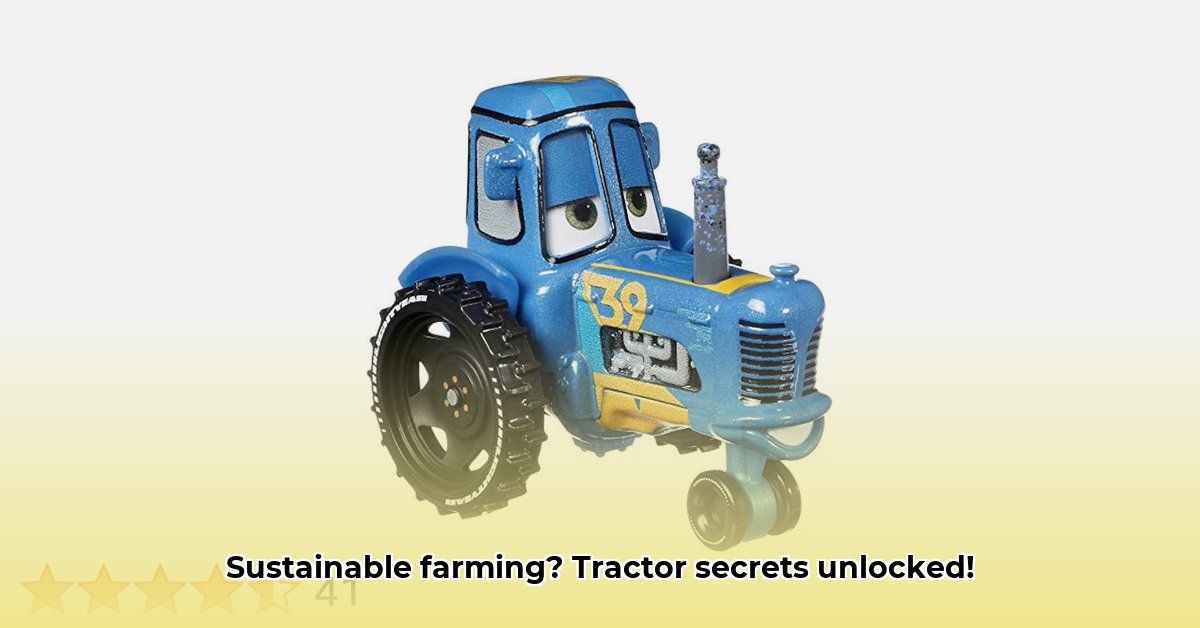
Tractor Cars: Unveiling Sustainable Farming Secrets in Ornament Valley
This case study examines the fictional Ornament Valley Tractor Operations from the Cars universe, exploring how their (implied) farming practices offer valuable insights into sustainable agriculture. While limited by the source material's narrative focus, this analysis extracts actionable intelligence and proposes improvements, bridging the gap between fantasy and practical application. The seemingly idyllic farm, run by manager Frank, provides a unique lens through which to examine real-world sustainable farming challenges and opportunities. For more on tractor applications in agriculture, see this resource.
Ornament Valley: A Farming Fable – Where Imagination Meets Reality
Picture a sun-drenched valley, reminiscent of Steinbeck's evocative landscapes, where the workforce consists of hardworking tractor cars. These aren't ordinary machines; they possess distinct personalities and a dedication to their tasks. Frank, the farm manager, oversees operations with apparent efficiency. The overall impression is one of harmony and productivity. But how sustainable is this seemingly idyllic scene? The film's narrative prioritizes character over detail, leaving many crucial aspects of their practices unstated. This necessitates creative interpretation, drawing parallels to established sustainable agriculture principles.
Decoding the Tractor Cars' Work Habits – Unveiling Implicit Sustainability
The quiet operation of the tractor cars suggests a commitment to minimizing noise pollution, a positive environmental practice. Their habit of "sleeping on their backs" after a workday serves as a powerful metaphor for the importance of regular maintenance and downtime – essential for both machines and human workers. Such restorative practices would undoubtedly increase equipment longevity and operational efficiency. Implicit in the narrative is likely the use of renewable energy (possibly solar, given the sunny setting), further aligning with sustainable ideals. However, the scale of energy consumption needed for this sizeable operation, and the efficiency of tractor-car adaptations remains unspecified.
Improving the (Fictional) Farm: Actionable Steps – A Roadmap for Sustainability
To optimize the fictional farm's sustainable practices, several actionable steps can be implemented:
For Frank (Farm Manager):
Implement a Daily Schedule (Short-Term): Establish a planned routine to prevent overwork, ensure consistent productivity, and optimize resource allocation. This operational efficiency strategy, akin to a "tractor wellness program," is a cornerstone of successful management.
Regular Maintenance (Short-Term): Establish a preventative maintenance schedule including routine checks, repairs, and necessary component replacements. This minimizes costly breakdowns and maximizes equipment longevity, mirroring best practices in real-world farming.
Invest in Tech (Long-Term): Integrate simple monitoring systems to track tractor efficiency and identify areas for improvement. Data-driven decision-making is crucial for optimizing resource use and minimizing waste.
Analog Crop Rotation (Long-Term): Implementing a systematic rotation schedule for field use can support soil health, mimicking real-world techniques crucial for sustainable agriculture.
For the Tractor Cars (The Workforce):
Planned Rest Time (Short-Term): Ensure sufficient downtime for rest and recharge. Preventing overwork fosters both worker morale (in this case, tractor "morale") and efficiency.
Quieter Work Environment (Short-Term): Explore strategies to minimize unnecessary noise, enhancing their working conditions and indirectly promoting better performance.
Workload Optimization (Long-Term): Optimize travel routes between fields to reduce unnecessary fuel consumption and time investment. This focuses on efficiency and resource management.
Equipment Upgrades (Long-Term): Continuously explore improvements to tools and equipment to simplify tasks and boost efficiency.
For the Ornament Valley Ecosystem:
Soil Health Monitoring (Short-Term): Regular soil testing is necessary to assess the effects of farming on soil health and provide valuable insight for adapting practices.
Biodiversity Assessment (Short-Term): Assess biodiversity to ensure a healthy ecosystem, which contributes to soil health and the overall farm's sustainability.
Soil Fertility Boost (Long-Term): Implement methods like composting or cover cropping to enhance soil fertility naturally, reducing reliance on chemical fertilizers.
Biodiversity Increase (Long-Term): Promote native flora and fauna to maintain a thriving ecosystem that supports the farm's sustainability.
Risks and Challenges: Drawing Parallels to the Real World
Even in a fictional setting, challenges abound:
| Risk Factor | Likelihood | Impact | Mitigation Strategy |
|---|---|---|---|
| Tractor Car Malfunction | Moderate | Moderate | Regular maintenance, readily available spare parts |
| Overworking Tractor Cars | Moderate | High | Strict scheduling, sufficient rest periods |
| Environmental Stress (Heat, Drought) | High | High | Efficient irrigation, shaded rest areas for tractors |
The Limits of Fiction: Bridging the Gap to Reality
This analysis, while insightful, is built upon a fictional foundation. Its limitations stem from the absence of real-world data necessary for comprehensive assessment. To overcome this:
Real-World Comparisons: Compare the implied practices with those of successful sustainable farms in analogous environments.
Data Collection: Conduct field studies in similar environments to gather data on soil health, crop yields, and environmental impact.
Technological Integration: Explore how technological advancements can complement sustainable farming techniques.
This fictional case study serves as a springboard, prompting reflection on sustainable farming practices. However, real-world data and research are paramount in crafting genuinely sustainable agricultural strategies.